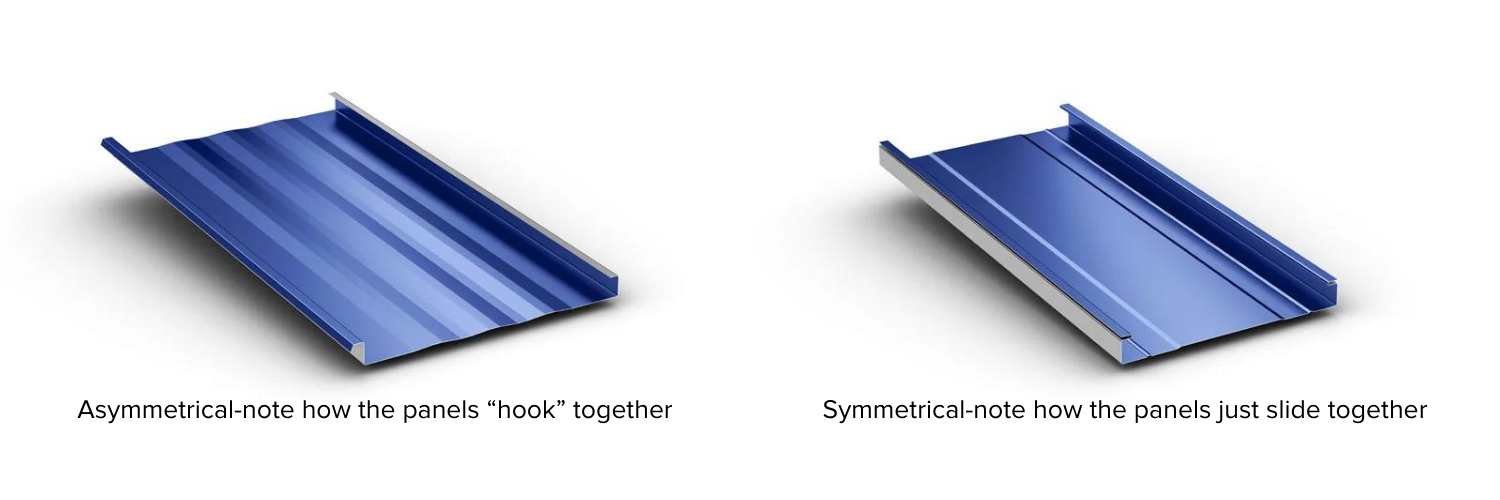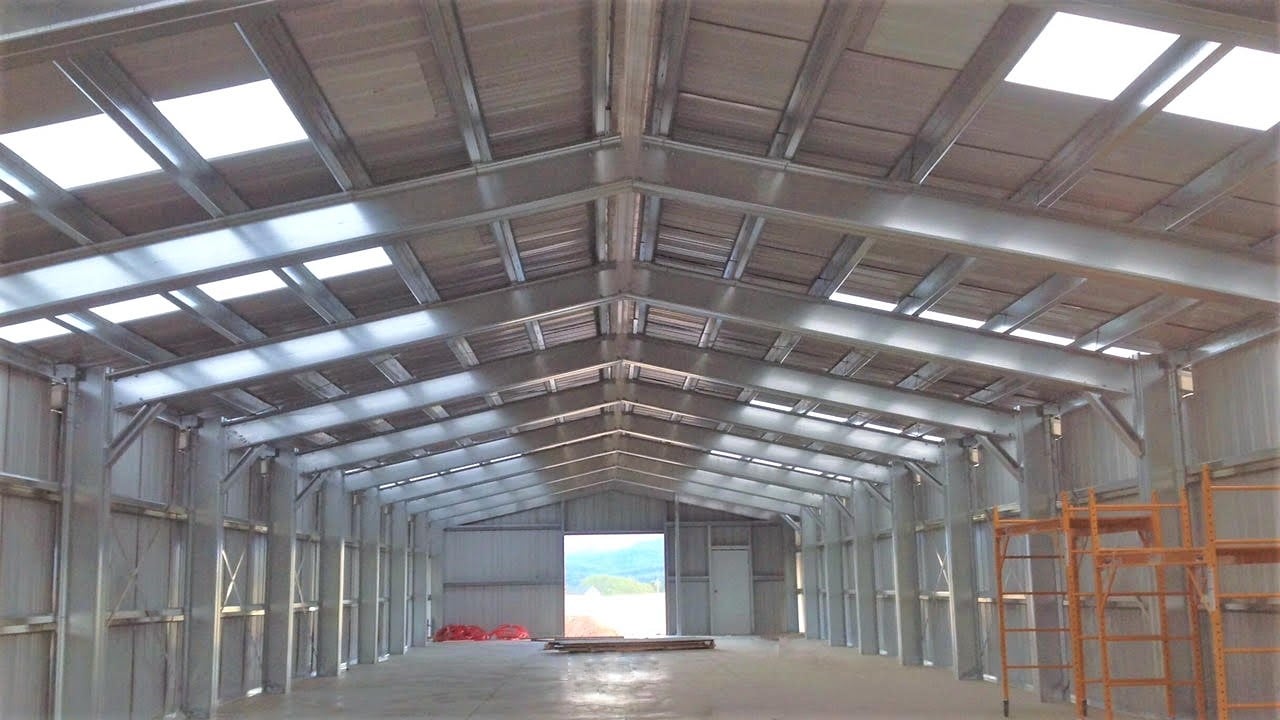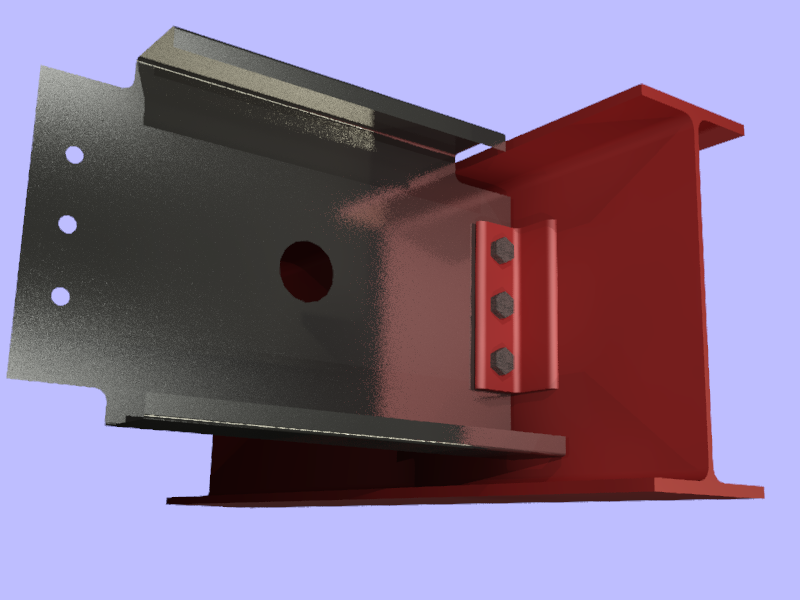15 Tips to Address the Labor Shortage
Due to the great resignation trend, it seems like we’re all trying to get more done with fewer people. While, unfortunately, we don’t have a magic cure to solve your staffing issues, we do have some time-saving tips to help maximize what your metal roofing and siding crews can accomplish.
Eave Notching
For contractors installing standing seam panels, factory eave notching is a great way to finish projects quickly. An architectural detail requires the removal of vertical panel legs to fold the panel at the eave. If you still have crews manually measure and cut the legs off each panel by hand, eave notching can be a game-changer for crew productivity.
Many panel manufacturers now offer factory panel notching on standing seam profiles. Factory eave notching typically takes about 2-3 minutes per panel, so it more than offsets the nominal upcharge of around .50 per panel.
Additionally, the finished appearance at the eave generally looks better since the notching occurs by automation vs. a manual operation with snips. To learn more, check out this page on our website or click the link below to watch a video.
Panel Packaging
Manufacturers typically bundle panels as they come off the mill, which means they get stacked from the longest to the shortest length. Then when the panels hit your site, it's up to your crew to break the banding and manually move the panels around to the proper location.
Imagine how much time you could save by having panels bundled by the roof and wall area, such as the northeast end wall or south roof area.
With project-specific packaging, panels can be placed in the proper area during the unloading process, saving your crew countless hours of moving panels around by hand. This practice also helps reduce panel damage since the factory packaging remains intact for longer on the jobsite.
Some manufacturers charge an additional fee for this service, as you might expect. At McElroy Metal, we’re proud to offer customized packaging at no additional charge in most cases.
Consider Trim Lengths
Your crews likely spend more time trimming out a building than installing panels. So it only makes sense to look for labor-saving ideas for trim applications. Consider the difference in time between installing one 20’ piece of trim or two 10’ pieces.
The 10’ option requires crew members to handle twice as much material, requires extra time to perform an adequate lap condition, and install sealants or butyl tape.
Laps can also create an aesthetic concern with owners and, perhaps most importantly, allow one more opportunity for water infiltration into the building. Minimize trim laps by working with a manufacturer like McElroy Metal which offers custom trim lengths up to 20’3” long.
Symmetrical Standing Seam
If you install standing seam panels, consider using a symmetrical panel instead of a non-symmetrical panel. The main differences between these panels involve the installation sequence and ease of future modifications.
Based on their panel design, non-symmetrical panels require a predetermined installation pattern, generally left to right. In contrast, you can install symmetrical panels in any order.
While it may seem minor, the labor differences between the two panels styles are significant. Since panels installation can happen in any order for symmetrical panels, crews can skip over difficult areas and return to them later.
Symmetrical panels also allow you to put less experienced guys on the simple roof areas and focus your experienced crew (and more expensive labor!) on the challenging sections. Symmetrical panel systems also offer easy repair or replacement of panels in the field of the roof without removal of unaffected panels. Click here to learn more about our symmetrical panel options.

Roofing Passport
If you chase residential work, programs like Roofing Passport can be incredibly beneficial from a time savings perspective. Roofing Passport uses aerial measurements to provide highly accurate material estimates all from the comfort of your home or office.
While there is a cost for the service (usually around $35 per project), it’s still a much quicker option than sending someone to each site for measurements and then doing the take-off and estimate by hand once you have the measurements. Beyond labor savings, you’ll save wear and tear on vehicles and the price of fuel. Check this out to learn more.
Cold-Formed Steel Buildings
While they’ve been widely used in Australia for the past 40+ years, the concept of cold-formed buildings is relatively new to the United States. Unlike post-frame buildings which use a wooden structure, cold-formed buildings rely on a steel frame and offer unique advantages.
For starters, they go up more quickly, which is a great way to save labor. Additionally, cold-formed building installation typically requires only a forklift instead of a crane. That means less skilled labor is needed.
Additionally, the building offers a 2-3 week lead-time vs. 8-10 months for pre-engineered buildings, so you can better control construction schedules in the current tight labor market. As an added benefit, cold-formed buildings require 25% less concrete for the footings. Check this out to learn more.

Wider Pan Widths
If you install standing seam panels, using wider panel widths is another excellent way to get more done with fewer people. Standing seam profiles typically come in widths from 12” to 24”. To understand how labor impacts pan width, consider a double sloped building 80’ wide by 100’ long.
When using a 24” panel, you would need 50 panels on each side, or 100 panels total. Conversely, a 16” panel would require 75 panels on each side or 150 total. Using a narrower panel means crews handle and install 50% more panels in this example.
Each additional panel requires your crew to stand up, go somewhere to get another panel, take it back to where they’re working on the roof, ensure squareness, and install. As you can see, the minutes add up quickly.
It is important to note that wider pan widths can be more prone to oil canning concerns. Using a striated profile in the pan usually mitigates any issue and is widely available from most manufacturers with no additional upcharge.
Substructural Punching
Using factory punching can offer substantial labor savings if you frequently use substructural components like Zees and Cees. Non-punched substructural members require crews to measure and drill each hole. In contrast, factory punched items arrive at the job site ready for installation.
Beyond the obvious time of measuring and drilling the members, factory punching reduces mistakes (and wasted labor!) compared to field drilling holes. Even when manufacturers have a small upcharge for special punching, you’re still saving precious time and money on the overall project.
Substructural XL
While we’re on the topic of substructural components, it’s only fitting to highlight the labor-saving benefits of our Substructural XL product. This product offers factory flange notching, which significantly reduces the need for field torching and cutting.
Beyond that, web sizes up to 24” and gauges up to 10 often eliminate the need for secondary welding. As you can imagine, the cost and labor savings with our Substructural XL product can be substantial but staying in control of the project timeline is another reason it’s quickly becoming a go-to product option for our customers. Learn more here.

Onsite Fabrication
While it’s not suited for every project, in some cases, on-site panel fabrication can help your crew start and finish a project more quickly! Conventional factory-produced products require extensive wood crating to ensure the panels arrive at the jobsite without damage.
After the panels arrive on the site, a crane typically hoists them to the roof plane. Once you’re ready to install the panels, crew members spend time opening the crates, removing the panels, dismantling the crates, hoisting the crates back to the ground, and then disposing of the wooden packaging material.
Each step requires people, which are admittedly challenging to find right now. In contrast, working with a manufacturer who produces the panels right onto the roof with onsite roll forming equipment eliminates most of those steps (and labor!).
Additionally, onsite fabrication allows for single-piece panels up to 250’ in length. In contrast, factory-produced panels typically fall in the 50-60’ window for maximum length, making lap conditions more common for large-scale projects.
Each lap condition requires crews to handle an additional panel, install sealants and fasteners. Consequently, lap conditions are time-consuming for crews to install and represent a source for future leaks that take even more of your time to investigate and repair.

Recover vs. Remove and Replace
Faced with a metal roof at the end of its life (normally 60+years), building owners often remove the old roof and replace it with a new metal roof. While that approach certainly works, you can also get more done with fewer employees by simply recovering the project instead of completing a remove and replace.
As the name implies, a roof recover means merely that new panels are installed over the top of the existing metal roof. In addition to saving the staffing to tear off and dispose of the old panels, your crews can install the new panels more quickly (and safely!) since they can work from a solid surface.
The best thing is that you’re not the only one that benefits from the recover approach vs. remove and replace. Your customers and building owners reap the rewards too. Recovers offer minimal (if any) disruption to building owners' employees and daily operations.
Inventory also isn’t exposed to the elements during the recover. And for those building owners not interested in adding insulation during the project, recover work is also exempt from the new energy code. To learn more, download our ebook below.
Minimize Suppliers
Life is admittedly busy. It often seems we don’t have enough hours in the day. As a result, retailers specializing in one-stop shopping have experienced phenomenal growth because consumers love the idea of buying everything from tires to groceries to clothing in one place. Why? It simplifies their lives.
Over time, we’ve seen those same buying tendencies in construction. Owners pressed for time are increasingly emphasizing buying more products from fewer vendors. And the labor shortage has driven behavior even more in this direction.
It often comes down to this: do you want to have a guy running all over town picking up a couple of things at each place, or would you rather order it all from one vendor (and perhaps even have them deliver it) which lets you use that employee for something else?
Consider Field Sealant Requirements
The use of sealants at trim and panel end lap conditions is pretty consistent across manufacturers; however, the similarities often stop there. Based on panel designs, some wall and roof panels require a continuous sealant bead to be placed during installation while other profiles do not.
The same holds for the clips frequently used for standing seam roof systems. Some manufacturers designed their system, so the sealant isn’t necessary on the actual clip while it's the expectation for others. The additional cost of the sealant is worth considering when deciding between suppliers, but the extra labor is often the more significant issue of the two.
Panel Lap Considerations
We discussed using on-site roll forming to avoid panel end lap conditions earlier. If on-site manufacturing isn’t an option, you typically have some options when placing your order that will make it much easier (and quicker!) for your crews to install a panel end lap.
Requesting lapped panels to be produced with panel notching, swedging and pre-formed holes can be a lifesaver for both crew efficiency and long-term performance.
In today’s labor starved market, streamlined approaches carry significant benefits. What labor-saving tips have we missed? Contact us or share your thoughts in the comments below.
About McElroy Metal
Since 1963, McElroy Metal has served the construction industry with quality products and excellent customer service. The employee-owned components manufacturer is headquartered in Bossier City, La., and has 14 manufacturing facilities across the United States. Quality, service and performance have been the cornerstone of McElroy Metal’s business philosophy and have contributed to the success of the company through the years. As a preferred service provider, these values will continue to be at the forefront of McElroy Metal’s model along with a strong focus on the customer.






.png?width=767&name=The%205%20Most%20Common%20Metal%20Roofing%20Installation%20Mistakes%20(And%20How%20to%20Avoid%20Them).png)
.png?width=440&height=293&name=How%20to%20Install%20Metal%20Roofing%20Over%20Existing%20Metal%20Roofs%20(1).png)


Comments on this article:
Scroll down to the bottom to submit a comment and join the conversation. Need help or have a question? Please contact us. Looking for a distributor or contractor? Please click here to get started.